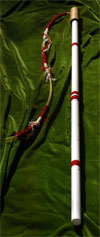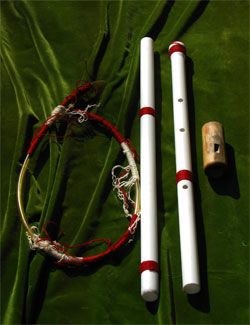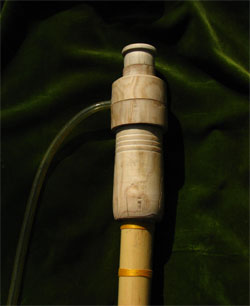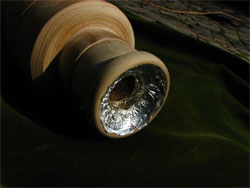 |
|
Fujara
The fujara (pronounced [fujara], foo-ya-ra) originated in central Slovakia as a large sophisticated folk shepherd's fipple flute of unique design. It is technically a contrabass instrument in the tabor pipe class.
Ranging from 115 to 190 cm long and tuned in A, G, and F. It has three tone holes located on the lower part of the main body. The sound is produced by a fipple at the upper end of the main body of the fujara. The air is led to the fipple through a smaller parallel pipe, called vzduchovod in Slovak (meaning "air channel"), mounted on the main body of the instrument. While it is possible to play the fundamental frequency on fujaras,[1] the normal playing technique is based on overblowing the instrument. Because of its aspect ratio (great length versus small internal diameter), the overtones created permit one to play a diatonic scale using only the three tone holes. The fujara is played standing, with the instrument held vertically, usually braced against the right thigh.
Technique and Role
The atypical design produces a deep, meditative timbre. Ornaments are traditionally added to the base melodies, which usually occur in the mixolydian mode. Two common types of ornaments are prefuk, the rapid overblowing of a single note, from the Slovak: prefukovat, to overblow; and rozfuk, a descending cascade of overtones, from the Slovak: rozfukat, to scatter.
Traditionally, the fujara was played by shepherds for recreation. Today, the fujara has moved from the shepherds' fields to the stage of folk festivals in the Slovak towns of Vychodna and Detva. The instrument has also left Slovakia and is played all over the world; particularly by aficionados of native flutes in Western Europe and North America. Despite this, the Fujara has yet to gain popularity or much recognition outside of Slovakia. Most often the fujara is a solo instrument, but ensembles of two or three fujaras have been known to exist, such as the Kubinec family or the Javorova Huzva trio.
The fujara was proclaimed in the UNESCO list of Masterpieces of the Oral and Intangible Heritage of Humanity in 2005."The Fujara and its Music" was inscribed on the Representative List of the Intangible Cultural Heritage of Humanity in 2008 by UNESCO.
information on the page http://en.wikipedia.org/wiki/Fujara
|
Plastic fujara. Not afraid of water and high temperatures, easy to clean. Disassembled, so it is convenient to transport. Wooden whistle and covered with natural beeswax. Flexible hose is coiled natural fibers. It allows to change position, to walk and dance during the game:)
Tonality of A Length: 150 cm |
Bamboo fujara Both ends wrapped with threads to avoid cracking bamboo. Block whistle chiseled with juniper and covered with beeswax. At the top is a basket of tobacco. Inside there are two valves of the direct and reverse action for an opportunity of simultaneous games and smoking. Tonality G. Length 170 cm video about fujara
|


 Fujara. Fujara-hookah
Fujara. Fujara-hookah
